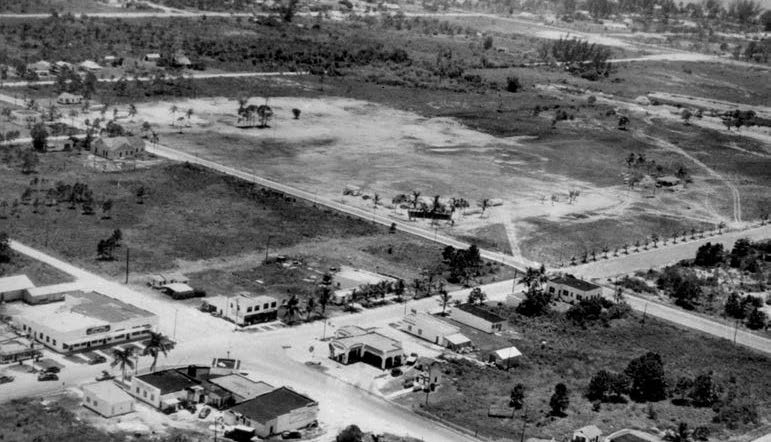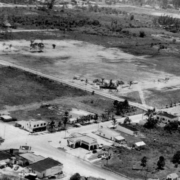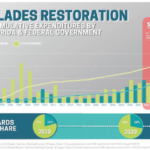The Naples Plan©

Cambier Park in 1948, the cleared area in the center.
by Lila Zuck, Naples Historical Society Historian
It was in 1948, during the second year of Naples Mayor W. Roy Smith’s first of seven two year terms in office that Council’s implementation of The Naples Plan commenced.
At that time, communities all over the United States were basking in the rays of World War II victory. Hope for a prosperous future filled hearts formerly beating in unison under an umbrella of uncertainty.
Throughout America a period of reconstruction took flight. In Naples, four initiatives to “Make Naples a Better Place to Live,” as described by the town council, were outlined in what was named “The Naples Plan”.
Rather than increase the millage rate of 28.5 mils, the town council decided to form a tax exempt organization whereby donations instead would fund the capital improvements and services outlined in the initiative.
Its formation was approved on January 9, 1948. The Naples Plan consisted of four components, the construction of a community park, construction of groins to control beach erosion, construction of new streets, and the inauguration and implementation of some form of mosquito control.
Community support was outstanding, as donations, not just from Naples but from every community in Collier County, began pouring in. Construction of a community park was undertaken first.
The site selected was a ten-and-three-quarter-acre parcel on 8th Street South opposite the entrance to the town hall donated to the Naples Plan by the Naples Company, under the direction of Henry B. Watkins, Sr.
The total construction cost of the park was $28,469.95, the bulk of which, $21,171.15, covered construction of the grandstand, restrooms, tennis courts and barbeque pits. The remainder paid for fill and grading.
The park was transformed into a community outdoor space from which every major community celebration and event was launched.
On July 5, 1948, the activities area was dedicated and the baseball diamond was officially christened by a Southwest Florida League baseball game between Naples and Estero.
Immokalee resident Robert Roberts and Collier County Sheriff Lewis Thorp, both cattle ranchers, donated steers for the occasion attended by 1,500 residents.
On Labor Day, Monday, September 6, 1948, the park was officially named for town engineer William Cambier, who by then had achieved the execution of the first four initiatives of The Naples Plan.
William Cambier was born in Milwaukee, Wisconsin in 1871. He was Chief Engineer of the Wisconsin & Northern Railroad Company from 1890 to 1924. In 1925 he was contracted to design a community building in Naples, and the following year was appointed town engineer by then Naples Mayor E. G. Wilkinson.
Upon assuming office he began drawing up plans to insure Naples would conform to Council’s vision for the town’s future, and in 1927 was instructed by Council to make an official map of Naples for Automobile Blue Books, Inc. He served simultaneously as Town Manager until May 1, 1942 when W. Roy Smith relieved him of that position.
Smith was elected mayor in 1946, serving simultaneously as Town Manager until February, 1949.William Cambier passed away on May 1, 1952 at age 80. On the evening of Memorial Day, May 30, 1953, after a performance by the State Road Department String Band, a memorial plaque was dedicated to the man whom former Naples Mayor William Clarke, Jr. referred to as “the best friend Naples ever had.”
Vice-Mayor Claude Storter described him as “a beloved official” who knew “the lands around Naples like the back of his hand, “recalling he was paid $150 a month and refused a raise because “that’s all the City can afford.”
The plaque and red brick monument to which it was affixed was donated by C. A. Tuell, the local contractor who built the bulk of Cambier Park. The sentiments of the community at large were engraved on the plaque: “In grateful memory of William Cambier 1871-1952, whose unselfish efforts made Naples a better place in which to live.”
Naples Historical Society is the Central Voice of Naples History and operates Historic Palm Cottage™ a 3500 square foot house museum opened to the public throughout the year.
This article is part of the Society Sage Stories series prepared exclusively for this publication. It was written in March, 2020, and is based primarily on the book Naples, A Second Paradise: The History of Naples, Florida (2010).
For more information go to www.NaplesHistoricalSociety.org.




Leave a Reply
Want to join the discussion?Feel free to contribute!